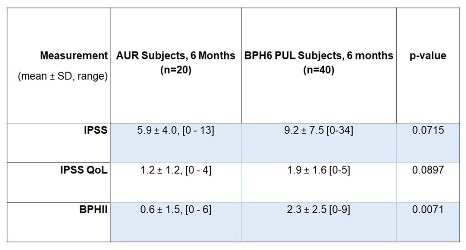Hypothesis / Aims of study
Acute urinary retention (AUR) in men is most commonly due to benign prostatic hyperplasia (BPH) and occurs most often in men 60-80 years old. AUR patients may be treated with alpha adrenoreceptor antagonists, but when medical management fails, treatment options to restore voiding are limited. The objective of this study was to assess the safety and feasibility of the Prostatic Urethral Lift (PUL) in patients with AUR secondary to BPH.
Study design, materials and methods
The study enrolled men ≥ 50 years of age with at least one failed voiding trial without catheter (TWOC) while on alpha blocker treatment, previous diagnosis of symptomatic BPH and prostate volume ≤ 100 cc. During PUL, small, permanent implants were placed to pull apart the prostatic lobes and open up the obstructed urethra. Void trials were performed 3 days (± 1 day) post-procedure. Symptom response (International Prostate Symptom Score, IPSS), quality of life (QoL), BPH Impact Index (BPHII), peak flow rate (Qmax), post void residual (PVR) and incontinence (Incontinence Severity Index, ISI) were assessed post-procedurally through 6 months. Results were compared with the previously published BPH6 randomized study (PUL versus TURP). Sexual function was measured using the Sexual Health Inventory for Men (SHIM) questionnaire. The rates of successful first TWOC and mean time to catheter independence were calculated. Patient satisfaction and return to normal were also assessed.
Results
52 men (age 71.4 ± 7.9 years, prostate volume 55.2 ± 22.8 cc) were enrolled across 6 centres. 40% had a history of LUTS for over 6 years. 67.4% of subjects failed at least 2 TWOCs prior to PUL, and mean baseline duration of catherization for all subjects was 132.4 days. PUL was successfully completed in all men with 4.8 ±1.4 implants per subject. 69% of subjects stopped alpha blocker treatment before PUL and remained medication-free through follow up. Mean IPSS (10.6 ± 7.8), QoL (1.6 ± 1.5) and BPHII (2.3 ± 2.8) at 6 weeks remained stable or further improved to IPSS (8.0 ± 6.5), QoL (1.1 ± 1.6) and BPHII (1.1 ± 2.6) at 3 months and IPSS (5.9 ± 4.0), QoL (1.2 ± 1.2) and BPHII (0.6 ± 1.5) at 6 months. The results were compared to BPH6 study outcomes for PUL at 6 months (Table 1). Outcomes at 3 months for Qmax (11.8 ± 6.6 AUR vs 13.6 ± 5.3 BPH6 PUL, p=0.2587) and for PVR (110.8 mL ± 84.6 AUR vs. 77.3 ± 74.4 BPH6 PUL, p=0.0973) were similar between studies. 58% of AUR subjects had a successful first TWOC at 3 days and 79% were catheter free by 1 month. The majority of subjects did not have incontinence at baseline (mean ISI 1.4 ± 0.9) and at 6 months, the majority remained incontinence free with results not inferior in number or level to baseline (ISI 1.3 ± 0.6). Incontinence results were compared to BPH6 PUL outcomes through 6 months, Table 2). Sexual function (mean baseline SHIM 16.0 ±8.7) was stable or improved (mean SHIM 18.7 ± 7.8) at 3 months. 89.5% subjects returned to normal in 7.4 days on average. 94.7% subjects reported being “much or very much better” and 84.2% would recommend the procedure at 6 months. Most adverse events were mild to moderate and resolved within two weeks. 3 subjects experienced related serious adverse events (1 urinary tract infection, 2 haematuria) that resolved within two weeks. 3 subjects underwent surgical intervention (2 HoLEP, 1 TURP), and 2 subjects underwent repeat PUL.
Interpretation of results
The results of this study show that PUL may be safely performed in BPH patients with AUR and a history of LUTS. The procedure can quickly restore normal voiding and render a large majority of patients catheter-free by 1 month. AUR subjects had similar IPSS and QOL scores and significantly better BPHII scores compared to PUL subjects from the BPH study at 6 months. Most patients discontinued alpha blockers prior to PUL and none of those patients needed to resume medication after PUL. In this study, most patients did not have incontinence at baseline and these results remained unchanged through 6 months with results similar to those seen in the BPH6 study. After PUL, erectile function was maintained if not improved through follow up. The patient experience was excellent, with high rates of patients returning to normal in about a week, self-reporting improvement and recommending the procedure.
Concluding message
PUL can safely and quickly restore normal voiding and significantly improve LUTS and quality of life in BPH patients suffering from AUR without compromise to continence or sexual function.
Figure 1

Table 1: Symptoms and Quality of Life in AUR Subjects Compared to BPH6 PUL Subjects at 6 Months
Figure 2

Table 2: Continence in AUR Subjects Compared to BPH6 PUL Subjects Over Time